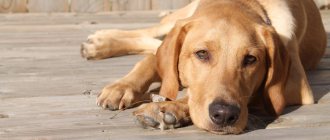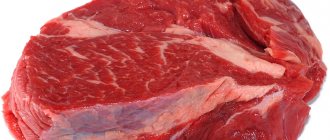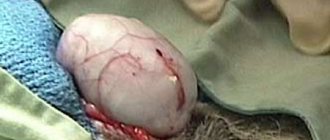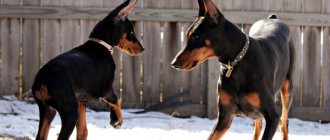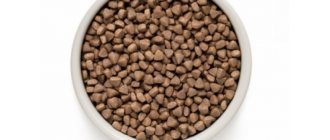Sterilizing a dog using the laparoscopic method is a minimally invasive surgical procedure. During the procedure, a veterinarian can not only remove the female’s reproductive organs, but also conduct an examination of the abdominal organs for diagnostic purposes.
Laparoscopy is performed using a special rigid endoscope and equipment inserted through the abdominal wall. The technique is gaining popularity due to the fact that the rehabilitation time for an animal after this type of surgical intervention is reduced significantly.
Sterilization of a dog at the Alisavet veterinary clinic means:
- surgery under sterile conditions without introducing infection into the body, so antibiotics are not needed;
- quick and easy awakening after surgery thanks to inhalation anesthesia;
- a long-acting pain reliever immediately after surgery, so there is no need to give injections at home;
- After the operation, there are no repeated appointments with the doctor - the pet will forget about the visit to the clinic within a day.
If you have any questions about dog sterilization, please write to us via chat
How is endoscopic sterilization performed?
The process of endoscopic sterilization occurs through small punctures in the peritoneum of a cat or dog. A video camera and instrument are inserted through these punctures. The image is displayed on the monitor. The veterinarian can see the patient's internal organs, magnified several times. This makes it possible to carefully examine the abdominal cavity from the inside. The surgeon finds and carefully removes the ovaries and ligates the vessels. The whole process is quick and simple. After this, the punctures are sealed with special medical glue.
The operation will relieve you and your pet from problems such as:
- constant search and purchase of disposable panties of the right size during the period of heat;
- damaged bed linen and carpets from unpleasant smelling marks;
- bites from persistent males that you have to constantly drive away from the bitch while walking;
- unplanned pregnancy of a dog during the summer season;
- financial expenses in the veterinary clinic to monitor the general condition of a pregnant pet;
- increased attention to the dog and newborns in the first couple of months after birth;
- wasting time selling or placing puppies in good hands;
- expensive dog handler services due to dog aggression - after sterilization the pet will become calmer and friendlier;
- treatment of the dog for possible diseases of the reproductive organs in the future;
- early loss of a pet - according to scientific data, those dogs that are sterilized on time live longer.
Sterilization of bitches: oophorectomy, ovariohysterectomy
Sterilization of a female dog
is the castration of a female animal, that is, the removal of the ovaries through surgery. You can find out the cost of sterilizing a dog in the price list for veterinary services for sterilization and castration of animals.
Why and at what age are animals sterilized?
Dogs are sterilized for 3 reasons:
✔️ the owner does not intend to use the dog for breeding
✔️ for disease prevention. The risk of oncological diseases of the genitourinary system and mammary glands is significantly reduced; also, sterilized animals do not suffer from pyometra, transmissible sarcoma and a number of other diseases, which in most cases lead to the premature death of an unsterilized animal. Therefore, it is worth noting that the life expectancy of sterilized animals is much longer.
✔️ According to indications (diseases of the uterus and ovaries, some tumors, severe and constantly recurring false pregnancy).
Sterilization of pets
consists in depriving them of their reproductive function by surgical intervention. This is removal of the ovaries (oophorectomy) or removal of the ovaries along with the uterus (ovariohysterectomy).
Our veterinarians will sterilize dogs, cats, and female ferrets at home and in the veterinary clinic. An unspayed female dog comes into heat twice a year. During this period, owners who do not plan to have puppies protect their dogs from contact with male dogs throughout their lives.
Timely sterilization of the dog
prevents problems associated with estrus, birth and unwanted puppies. It is not uncommon for non-pregnant dogs to experience a false pregnancy 2 months after estrus, accompanied by behavioral changes and strong milk production. Sterilization is indicated for animals with pronounced false pregnancy. Sterilizing a dog also protects against various sexually transmitted diseases, eliminates the possibility of tumors of the uterus and ovaries, prevents inflammation of the uterus and significantly reduces the likelihood of tumors of the mammary glands.
At what age can a dog be registered for sterilization?
Scientific research has established that in case of urgent need, sterilization can be carried out from 3 months of age until old age (depending on the average life span of a particular breed).
However, there is some common sense. If you don’t find anything related to your situation in the list below, then it is advisable to sterilize the dog before the 3rd heat .
The operation should be done as soon as possible if:
- during a walk you let your pet run around without a leash;
- the dog does not yet know the commands and does not come running to you when you call;
- the pet lives in the country and moves freely outside the fence;
- There is no longer a neutered dog at home, and breeding is not part of your plans.
Castration of male dogs (laparoscopy) in Moscow
Some owners of male dogs want their animal to be castrated while maintaining its appearance. Castration of dogs laparoscopically provides this opportunity; the vas deferens are simply coagulated for the male dog. The veterinary clinic's services also include a laparoscopic method for the treatment of cryptorchidism (undescended testicle). It allows you to quickly detect the testicle, which reduces the operation time; the absence of abdominal incisions also facilitates the postoperative period.
In order to find out the price for laparoscopy of a dog, you can contact the indicated telephone numbers. Our employee will answer all your questions. If you need high-quality and professionally performed sterilization of dogs in the North-Eastern Administrative District and other areas of Moscow, contact our clinic.
Which dog sterilization is better - abdominal or laparoscopic?
Previously, sterilization of dogs was carried out only in the form of abdominal surgery, making impressive incisions and applying many stitches, which required special care for 10-14 days and subsequent removal. During this period, antibiotic injections were given. Problems for the owner were caused not only by the stitches and injections, but also by the general condition of the dog - the post-operative painful period (it was difficult for the pet to get up, eat and walk).
A few years later, the method of operation was improved - surgeons, if possible, make a mini-incision and apply a cosmetic suture, which does not need to be processed or removed . However, the recovery period is still not very pleasant for the pet.
Cosmetic stitch after sterilization of a small breed dog
Laparoscopic sterilization of a dog
Since 2022, Alisavet has added new endoscopic equipment for humane sterilization of dogs using the laparoscopic method using one or two mini-punctures .
Thanks to the LigaSure bipolar ligation technology from B.BRAUN AESCULAP® CAIMAN®, the ovaries and uterus are now removed by cutting the tissue while sealing the blood vessels, so there is no need for internal sutures, which eliminates even the slightest bleeding.
A difficult postoperative period in the past: no lying with a “rag” and “drunken gait” - the dog after laparoscopic sterilization does not feel pain, eats well and leads its normal lifestyle
Laparoscopy is a modern, safe and less traumatic way for a pet to remove reproductive organs, so now it will NOT:
- cuts;
- excruciating pain after surgery;
- sutures (special skin glue is used to connect the skin or an internal suture is applied that does not need to be removed);
- antibiotics after sterilization (mini puncture ensures maximum sterility).
To prevent your dog from licking a wound or puncture(s) on the first day, put on a post-operative blanket.
Mini punctures during laparoscopic sterilization of a medium breed dog
Laparoscopic sterilization is especially good for medium and large breed dogs due to certain anatomical features
Process Features
First, the veterinarian examines the animal. This helps to avoid risks and complications associated with the manipulations performed. For example, allergies to any medications or intolerance to substances are excluded. The specialist will tell and explain to the owner how the operation will be carried out.
Laparoscopy of dogs and cats – stages:
1. Preparation. After an external examination and clarification of health details, the surgeon gives permission for further steps. Excision of the gonads from the pelvis is allowed only after a fasting diet - for 5-10 hours. Sometimes blood donation is required for tests.
2. Premedication. Drugs are injected into the body to knock the patient out of consciousness and provide anesthesia. Manipulations on pets are performed only under general anesthesia, no local anesthesia.
3. Sterility. The insertion sites for the laparoscope are prepared and treated with an antiseptic solution, which minimizes the possibility of infection.
4. Operation. The necessary organs are removed through the holes. Doctors do not apply a ligature, but coagulate the ovarian ligaments with a bipolar device. Defects in the muscle tissue are sutured with ordinary material, and the skin is glued together.
Castration of cats using laparoscopy lasts only 30 minutes. The pets will soon recover from anesthesia. At this time, it is better to leave the patient in the clinic. Afterwards, the pet is taken home, where it continues to behave in its usual way. There is no need to wear a blanket as protection due to the easier recovery period.
Is it necessary to prepare a dog for sterilization?
Needed. Preoperative preparation is important for a dog of any breed and age. Examination and examinations will reduce possible risks during anesthesia and in the postoperative period.
At the discretion of the cardiologist and anesthesiologist, the animal usually undergoes an ECHO cardiac screening or ECG (electrocardiogram) before sterilization.
If a dog has a genetic breed predisposition to heart disease, has chronic diseases, or any pathology is revealed during the initial examination, then before the operation a comprehensive detailed examination is carried out: a complete echocardiography of the heart, blood donation for general and biochemical tests, and sometimes x-rays .
You can refuse preliminary diagnostic procedures, but then the responsibility for the pet’s health falls on your shoulders, since the surgeon is forced to sterilize an unexamined animal.
The dog should not be fed 10-12 hours before surgery (water is freely available)
The process of endoscopic sterilization.
How is endoscopic sterilization performed in our veterinary clinic?
- You bring your pet at the appointed time. We perform heart screening in front of you and pick up the patient.
- Patient in anesthetized sleep. Through small punctures, an instrument and endoscopic optics with a video camera are inserted into the abdominal cavity, through which the surgeon “looks.”
- The picture “from the inside” is transmitted to the screen in the highest quality FullHD.
- The specialist maintains full control and examines the condition of the patient’s internal organs.
- Through the punctures, the surgeon carefully removes the ovaries. Blood vessels are ligated using a special technology.
- Next, the punctures are closed using medical glue.
- After some time, your pet wakes up. All this time he is continuously monitored by an anesthesiologist.
- After you fully awaken, we call you and invite you to the clinic. Your beloved four-legged friend will meet you in normal condition.
How much does safe sterilization cost?
- 100% guarantee that the operation is carried out under sterile conditions in compliance with sanitary standards.
- Sterilization is carried out by a surgical team: an anesthesiologist, a surgeon and an assistant. Each employee is focused on a specific task, which improves the quality of the operation.
- Alisavet uses a modern and most controlled type of anesthesia - inhalation.
Dear owner, within 14 days after surgery, we ask you to bring your pet to the attending veterinarian for a free follow-up examination and removal of sutures
Surgical laparoscopy
Surgical laparoscopy, or minimally invasive surgery, can be used by veterinarians to perform a wide variety of procedures. The advantages of laparoscopic surgery over traditional surgery are minimally invasive, aseptic, reduced postoperative pain, and aesthetics.
Laparoscopy includes such types of surgical interventions as:
- Ovariectomy - removal of the ovaries
- Hysterectomy
- Chocystectomy - removal of the gallbladder
- Removal of small tumors
- Gastropexy
Select the weight category of your pet, and then the desired surgical technique:
Your dog weighs:
- up to 5 kg
- from 5 to 15 kg
- from 15 to 25 kg
- from 25 to 35 kg
- from 35 to 45 kg
- more than 45 kg
For your convenience, use this is a safe way to get to Alisavet and back home
Sterilization of a dog weighing up to 5 kg
Cavity sterilization of dogs weighing up to 5 kg
We provide the service in all branches of the Alisavet network
The price includes:
- preoperative examination by a surgeon
- inhalation anesthesia
- abdominal ovariohysterectomy along the white line of the abdomen
- application of an intradermal self-absorbing suture
- Consumables
Present:
- nail trimming (407₽)
- postoperative blanket (300₽)
You will save 707₽
Price
15 154₽
Register your pet
Laparoscopic sterilization of dogs weighing up to 5 kg
We provide the service in branches on Witte Alley and st. Chobotovskaya
The price includes:
- preoperative examination by a surgeon
- inhalation anesthesia
- mini puncture ovariohysterectomy
- Consumables
Present:
- nail trimming (407₽)
- postoperative blanket (300₽)
You will save 707₽
Price
17 533₽
Register your pet
Sterilization of a dog weighing from 5 to 15 kg
Cavity sterilization of dogs weighing from 5 to 15 kg
We provide the service in all branches of the Alisavet network
The price includes:
- preoperative examination by a surgeon
- inhalation anesthesia
- abdominal ovariohysterectomy along the white line of the abdomen
- application of an intradermal self-absorbing suture
- Consumables
Present:
- nail trimming (from 407₽)
- postoperative blanket (from 350₽)
You will save at least 757₽
Price
16 281₽
Register your pet
Laparoscopic sterilization of a dog weighing from 5 to 15 kg
We provide the service in branches on Witte Alley and st. Chobotovskaya
The price includes:
- preoperative examination by a surgeon
- inhalation anesthesia
- ovariohysterectomy with mini punctures
- Consumables
Present:
- nail trimming (from 407₽)
- postoperative blanket (from 350₽)
You will save at least 757₽
Price
20 733₽
Register your pet
Sterilization of a dog weighing from 15 to 25 kg
Cavity sterilization of dogs weighing from 15 to 25 kg
We provide the service in all branches of the Alisavet network
The price includes:
- preoperative examination by a surgeon
- inhalation anesthesia
- abdominal ovariohysterectomy along the white line of the abdomen
- application of an intradermal self-absorbing suture
- Consumables
Present:
- nail trimming (from 407₽)
- postoperative blanket (from 400₽)
You will save at least 807₽
Price
17 533₽
Register your pet
Laparoscopic sterilization of a dog weighing from 15 to 25 kg
We provide the service in branches on Witte Alley and st. Chobotovskaya
The price includes:
- preoperative examination by a surgeon
- inhalation anesthesia
- ovariohysterectomy with mini punctures
- Consumables
Present:
- nail trimming (from 407₽)
- postoperative blanket (from 400₽)
You will save at least 807₽
Price
27 134₽
Register your pet
Sterilization of a dog weighing from 25 to 35 kg
Cavity sterilization of dogs weighing from 25 to 35 kg
We provide the service in all branches of the Alisavet network
The price includes:
- preoperative examination by a surgeon
- inhalation anesthesia
- abdominal ovariohysterectomy along the white line of the abdomen
- application of an intradermal self-absorbing suture
- Consumables
Present:
- nail trimming (from 407₽)
- postoperative blanket (from 450₽)
You will save at least 857₽
Price
19 064₽
Register your pet
Laparoscopic sterilization of a dog weighing from 25 to 35 kg
We provide the service in branches on Witte Alley and st. Chobotovskaya
The price includes:
- preoperative examination by a surgeon
- inhalation anesthesia
- ovariohysterectomy with mini punctures
- Consumables
Present:
- nail trimming (from 407₽)
- postoperative blanket (from 450₽)
You will save at least 857₽
Price
34 648₽
Register your pet
Sterilization of a dog weighing from 35 to 45 kg
Cavity sterilization of dogs weighing from 35 to 45 kg
We provide the service in all branches of the Alisavet network
The price includes:
- preoperative examination by a surgeon
- inhalation anesthesia
- abdominal ovariohysterectomy along the white line of the abdomen
- application of an intradermal self-absorbing suture
- Consumables
Present:
- nail trimming (561₽)
- postoperative blanket (from 500₽)
You will save at least 1061₽
Price
20 733₽
Register your pet
Laparoscopic sterilization of a dog weighing from 35 to 45 kg
We provide the service in branches on Witte Alley and st. Chobotovskaya
The price includes:
- preoperative examination by a surgeon
- inhalation anesthesia
- ovariohysterectomy with mini punctures
- Consumables
Present:
- nail trimming (561₽)
- postoperative blanket (from 500₽)
You will save at least 1061₽
Price
38 823₽
Register your pet
